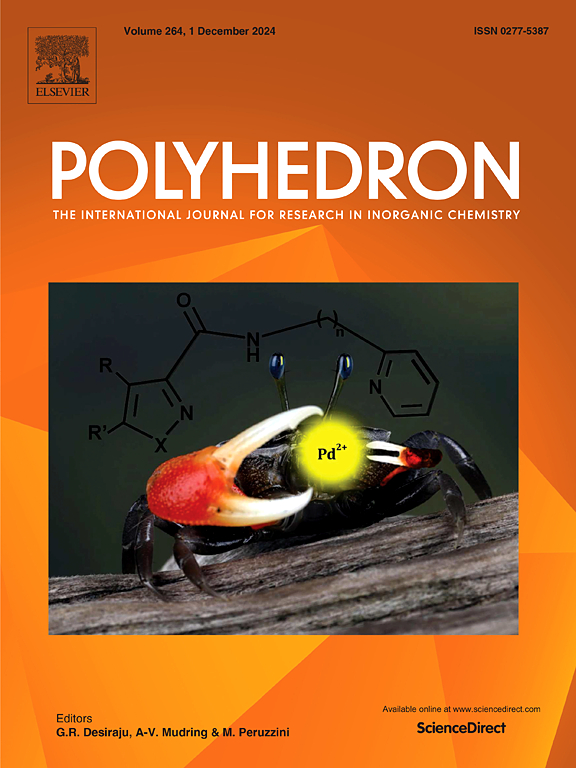A comprehensive review on the rational design of MOF-based heterogeneous catalysts for the classic Biginelli reaction
IF 2.4
3区 化学
Q2 CHEMISTRY, INORGANIC & NUCLEAR
引用次数: 0
Abstract
The classic Biginelli reaction is a sustainable and powerful tool for synthesizing dihydropyrimidinone scaffolds (DHPMs) through an acid-catalyzed one-pot-three component process. Since such a multi-component reaction is accompanied by an entropy decrease in the transition state, utilizing a heterogeneous porous catalyst with abundant acidic sites will be beneficial. Activating reagents within catalyst cavities, which act as nanoreactors, helps stabilize the tightly bound transition state, reducing the activation energy and accelerating the reaction rate. As a unique class of porous crystalline materials with intrinsic acidic properties, metal–organic frameworks (MOFs) offer promising potential for catalyzing this reaction. Their catalytic activity originates from defects in the crystalline lattice and/or from functional groups on their organic linkers and/or inorganic nodes. Additionally, encapsulating catalytic guest species inside their pores can further enhance their catalytic activity. Furthermore, functionalizing the outer surface of MOF particles or hybridizing them with other materials can further tailor their properties, offering improved performance based on the nature of the materials incorporated. This review explains the current state-of-the art in using MOF-based solid platforms as porous heterogeneous catalysts for the classic Biginelli reactions. After providing a background introduction to the Biginelli reaction, its mechanistic aspects and the methods for characterizing MOF-based catalysts are reviewed. Finally, conclusion, challenges, and future trends were discussed. Despite the numerous reviews exist on the Biginelli reaction, no comprehensive study has specifically focused on the use of MOFs as catalysts for this reaction. This review aims to address this gap by presenting a detailed overview of MOFs as powerful and versatile heterogeneous catalysts for the Biginelli reaction. We hope this critical appraisal will serve as a foundation for researchers to design and develop more efficient MOF-based catalysts for this important transformation.

经典Biginelli反应中mof基非均相催化剂的合理设计综述
经典的Biginelli反应是通过酸催化的一锅三组分工艺合成二氢嘧啶支架(dhpm)的一种可持续和强大的工具。由于这种多组分反应伴随着过渡态熵的减少,因此使用具有丰富酸位的多相多孔催化剂将是有益的。催化剂腔内的活化剂作为纳米反应器,有助于稳定紧密结合的过渡态,降低活化能,加快反应速率。金属有机骨架(MOFs)作为一类独特的具有固有酸性的多孔晶体材料,在催化该反应方面具有很大的潜力。它们的催化活性源于晶格中的缺陷和/或其有机连接和/或无机节点上的官能团。此外,将催化客体包封在其孔隙中可以进一步提高其催化活性。此外,功能化MOF颗粒的外表面或将其与其他材料杂交可以进一步调整其性能,根据所结合材料的性质提供改进的性能。这篇综述解释了目前使用mof基固体平台作为经典Biginelli反应的多孔非均相催化剂的最新进展。介绍了Biginelli反应的背景,综述了Biginelli反应的机理和表征mof基催化剂的方法。最后,讨论了结论、挑战和未来发展趋势。尽管对Biginelli反应已有大量的评论,但没有专门针对mof作为该反应催化剂的综合研究。本文旨在通过详细介绍mof作为Biginelli反应的强大和通用的多相催化剂来解决这一空白。我们希望这一重要的评价将为研究人员设计和开发更有效的基于mof的催化剂奠定基础,以实现这一重要转变。
本文章由计算机程序翻译,如有差异,请以英文原文为准。
求助全文
约1分钟内获得全文
求助全文
来源期刊

Polyhedron
化学-晶体学
CiteScore
4.90
自引率
7.70%
发文量
515
审稿时长
2 months
期刊介绍:
Polyhedron publishes original, fundamental, experimental and theoretical work of the highest quality in all the major areas of inorganic chemistry. This includes synthetic chemistry, coordination chemistry, organometallic chemistry, bioinorganic chemistry, and solid-state and materials chemistry.
Papers should be significant pieces of work, and all new compounds must be appropriately characterized. The inclusion of single-crystal X-ray structural data is strongly encouraged, but papers reporting only the X-ray structure determination of a single compound will usually not be considered. Papers on solid-state or materials chemistry will be expected to have a significant molecular chemistry component (such as the synthesis and characterization of the molecular precursors and/or a systematic study of the use of different precursors or reaction conditions) or demonstrate a cutting-edge application (for example inorganic materials for energy applications). Papers dealing only with stability constants are not considered.
 求助内容:
求助内容: 应助结果提醒方式:
应助结果提醒方式:


